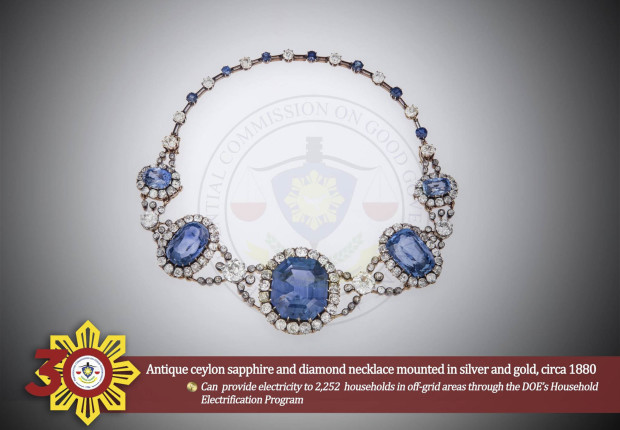
VIRTUAL DISPLAY This antique Ceylon sapphire and diamond necklace is among those on display on the Facebook page of the PCGG
TO HELP the young generation understand the extent of the Marcos dictatorship’s excesses, the Presidential Commission on Good Government (PCGG) recently unveiled a digital exhibit of jewelry from the Hawaii collection that could’ve otherwise provided for essential government projects such as school buildings.
The initiative, dubbed “Virtual Jewelry Exhibit, A Story of Excesses: What Could Have Fueled A Nation’s Development,” aims to post regularly on social media sites such as Facebook and Twitter images of select jewelry pieces from the Hawaii collection “to show and remind the present generation of the excesses and extravagance of the Marcoses in their two-decade dictatorship.”
“The commission believes that it is its duty to remind Filipinos, especially the youth, of the real history. Through this online exhibit of the family’s collection of diamonds, gold, even tiaras, the PCGG hopes that the youth can visualize how the Marcoses abused the government coffers, part of history [that] is not in the history books,” the PCGG said in a recent statement.
Among the featured pieces from the Hawaii jewelry collection are a brilliant baguette and oval-cut diamond coronet in white gold with comb, which the PCGG said could have financed the construction of eight one-story classrooms; a Belle Époque diamond tiara in platinum with French marks, which could have funded the treatment of more than 12,000 tuberculosis cases; and an 1880 antique Ceylon sapphire and diamond necklace mounted in silver and gold that could have provided power to more than 2,200 households in off-grid areas in the country.
P1 billion worth
While the PCGG did not indicate the individual price of the jewelry pieces, a recent appraisal by auction houses Christie’s and Sotheby’s valued at least P1 billion the three jewelry collections seized from the Marcoses and their associates in 1986, following the toppling of the dictatorship.
The three jewelry collections kept at the Bangko Sentral ng Pilipinas are the Hawaii, Malacañang and Roumeliotes collections.
The Hawaii collection, composed of 300 pieces, was seized by the US customs bureau following the Marcoses’ arrival in Hawaii in 1986. The recent appraisal revealed that an
“extremely rare” pink diamond, worth at least P235 million ($5 million), was in this collection.
The Malacañang collection is composed of around 400 pieces of jewelry left behind by the dictator’s family as they fled the country, while the Roumeliotes collection was seized from Greek businessman Demetriou Roumeliotes, who attempted to smuggle out of the country a week after the 1986 Edsa People Power Revolution at least 60 jewelry pieces, in violation of the Tariff and Customs Code.
The PCGG said that apart from having a virtual exhibit of the jewelry pieces as part of its 30th anniversary activities, it will also mount a Good Governance Caravan in universities nationwide “to give the youth the opportunity to hear first-hand the dark stories of the martial law [era] and the excesses of the Marcos family and [their] cronies.”
“It is [our] hope that the youth who are too young to have lived or endured the struggles during the dictatorship or those who have comfortably forgotten shall once again relive the fire that burned in the hearts of the Filipino people who marched on Edsa, who desperately but peacefully wanted change. So that young and old can say with knowledge or conviction, never again!” the PCGG said.
The PCGG’s virtual exhibit can be viewed at www.facebook.com/TheNewPCGG and through Twitter @TheNewPCGG.